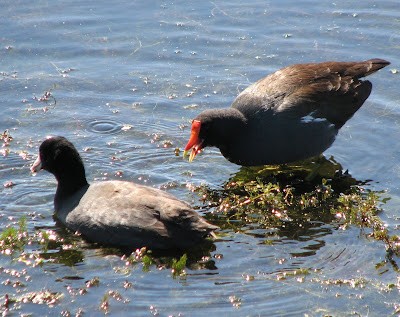We decided to spend Sunday morning looking for warblers at the Edith L Moore Sanctuary. At most times of the year this isn't a great birding site but in the spring it's a good place to see warblers on their northern migration.
After admiring the Tennessee Warbler - and a Ruby-crowned Kinglet that was buzzing it - we drove down to Edith Moore. There we got out of the car, looked up and immediately saw a Northern Parula.
The garden had butterflies ...
while the pond had a group of Red-eared Sliders.

We really enjoyed walking the creekside trails for the next 90 minutes, although we weren't very successful at finding warblers. The most common birds were White-eyed Vireos, Blue-gray Gnatcatchers and Ruby-crowned Kinglets. However, we did see another Northern Parula and a Nashville Warbler. Then came the sighting of the day: A very helpful birder called Charmaine showed us a Worm-eating Warbler, US life bird #426 for me.
Back at the cabin, the feeders were attracting a succession of Blue Jays, Northern Cardinals, Tufted Titmice, Red-bellied Woodpeckers, Mourning Doves and American Goldfinch.

American Goldfinch
Our final bird of the day was this White-eyed Vireo.

Edith L Moore
The sanctuary entrance is at 440 Wilchester Boulevard, just south of Memorial a few hundred yards west of the West Sam Houston Parkway. It is open 7:00 a.m. - 7:00 p.m. every day of the year and entry is free.





































